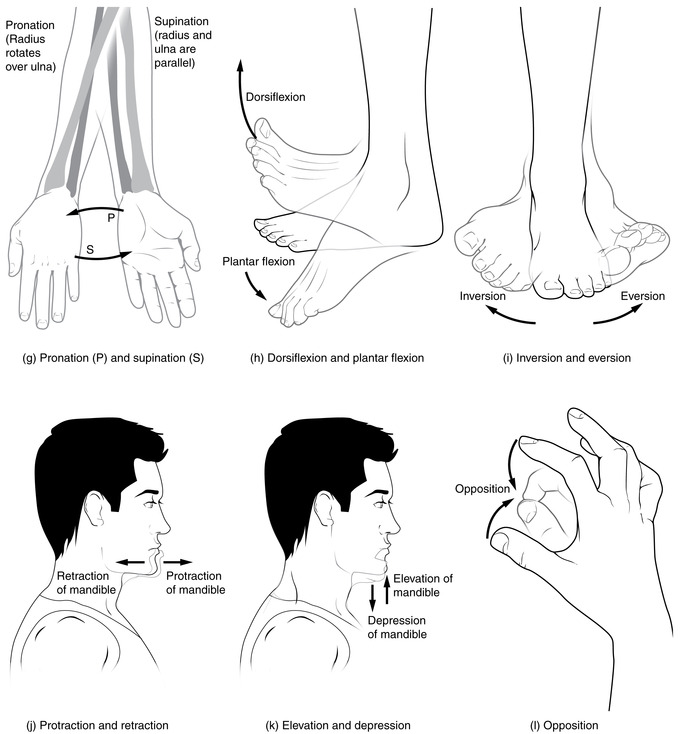This type of joint allows bones to glide over one another. Gliding movements occur as relatively flat bone surfaces move past each other.

8 4e Synovial Joint Movements Medicine Libretexts
A twisting motion of the foot that turns the sole inward is called __________.

. The wrist joint and the tarsals of the foot are two common examples of the gliding movement. Gliding joints are formed by the ends of bone joining. A Gliding movements occur at the intercarpal and intertarsal joints.
The joints of the carpal and tarsal bones are examples of joints that produce gliding movements. A freely mobile joint is classified as a diarthrosis. Which of the following is not considered a special movement that occurs at only certain joints.
Between the carpals and the metacarpals of the palm. Science Anatomy and Physiology QA Library regarding gliding movements. Articular cartilage between the bones provides a smooth rubbery surface that both aids in the gliding motion and acts as a shock absorber during impacts to the bones.
The joints of the carpal and tarsal bones are examples of joints that produce gliding movements. Between the tarsal bones of the ankle. A gliding joint plane joint or planar joint is a common type of synovial joint built between bones that meet on flat or nearly flat articular surfaces.
Many gliding joints are formed in the appendicular skeleton between the carpal bones of the wrist. Gliding movements produce very little rotation or angular movement of the bones. BGliding movements allow flexibility of the upper limbs.
The upper head of the lateral pterygoid muscle draws the disc or meniscus anteriorly and prepares for condylar rotation. Gliding movements occur as relatively flat bone surfaces move past each other. A joint cavity is present.
The joints of the carpal and tarsal bones are examples of joints that. There are three types of motion possible at a gliding joint. Joint permits gliding 5.
There are also other gliding joints located between the tarsal bones as well. This enables them to slide bend and twist. Gliding movements occur as relatively flat bone surfaces move past each other.
Joint is uniaxial 7. Ball and socket joint Note. This type of movement occurs in the temporomandibular joint after opening when the condyles and disks move forward as in protrusion of the jaw.
Gliding movements produce very little rotation or angular movement of the bones. There are several gliding joints located in the ankles. The main one located in the ankle is found where the two bones in the bottom part of your leg the fibula and tibia and the tarsal bones in your foot meet.
Angular movements are produced when the angle between the bones of a. The answer is a true. Linear motion for instance smooth sliding of bone past bone this is why the joints seem to glide angular movement such as bending and stretching and circular movement.
All of these special movements. Slight rotations can also occur at these joints but are limited by the shape of the and the elasticity of. Gliding translation or sliding movement occurs in the upper cavity of the temporomandibular joint whereas rotation or hinge movement occurs in the lower cavity Rotation occurs from the beginning to the midrange of movement.
Adjoining bones are covered with articular cartilage. B Gliding movements allow flexibility of the upper limbs. Gliding movements occur as relatively flat bone surfaces move past each other.
CAn example of a gliding movement is nodding ones head. Which of the following represents a type of movement where there is a decrease in the angle between articulating bones. Which combination of statements accurately describes the joint highlighted in the picture.
Gliding joints allow the bones to glide past each other in either direction along the joint plane up and down right and left and diagonally. So the answer is A. AGliding movements occur at the intercarpal and intertarsal joints.
Gliding movements produce very little rotation or angular movement of the bones. Gliding movement Movement of one surface over another without angular or rotatory movement as well. C Gliding movements are multiaxial.
Gliding occurs at what type of joint. They produce very little rotational or angular movement of the bones. The answer is d plane joint also called a planar joint.
Decreasing the angle between bones in the sagittal plane is called __________. D An example of a gliding movement is nodding ones head. Joint is biaxial 8.
There are even more gliding joints located in the wrist. The joints of the carpal and tarsal bones are examples of joints that. Joint permits flexionextension 6.
Movement Medical Dictionary 2009 Farlex and Partners Want to thank TFD for its existence.

Joints And Skeletal Movement Boundless Biology
19 3 Joints And Skeletal Movement Concepts Of Biology 1st Canadian Edition
0 Comments